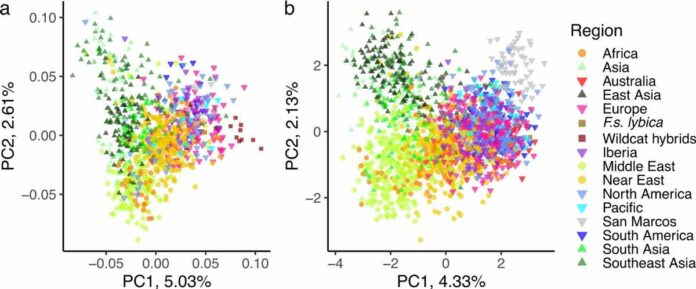It may take a minute to notice the difference between a housecat and its direct ancestor, the Near Eastern wildcat. They’re roughly the same size and shape and they both resemble cats. The wildcat is fierce and feral. Whereas the housecat, thanks to nearly 10,000 years of domestication, has become the world’s most popular pet. Scientists are now attempting to identify the genetic changes that resulted in this remarkable transformation. Based on the first high-quality sequence of the cat genome, the findings could shed light on how other creatures, including humans, become tame.
Cats first appeared in human society around 9500 years ago. It is shortly after people began farming in the Middle East. Wildcats slunk out of the deserts and into villages. They were drawn to rodents that had infested grain stores. Many scientists believe that they mostly domesticated themselves there. They were the friendliest ones who were able to benefit from human table scraps and protection. Cats shrank slightly in size over thousands of years. They acquired a plethora of coat colours and patterns and shed their antisocial tendencies. Domestic animals ranging from cows to dogs have undergone similar transformations. But scientists know little about the genes involved.
Some of them have now been identified by researchers led by Michael Montague, a postdoctoral fellow at Washington University School of Medicine in St. Louis. The scientists began with a draught genome of a domestic cat, a female Abyssinian. They then filled in missing sequences and identified genes. The resulting genome was compared to those of cows, tigers, dogs, and humans.
The study was published this week in the Proceedings of the National Academy of Sciences. They discovered 281 genes in domestic cats that show signs of rapid or numerous genetic changes. It is a hallmark of recent selection. Some appear to be involved in hearing and vision. It is two of the most important senses for felines. Others are involved in fat metabolism and are most likely an adaptation to cats’ carnivorous lifestyle.
The most intriguing results came when the researchers sequenced the genomes of 22 domestic cats from various breeds and locations. Scientists compared them to the genomes of two Near Eastern and two European wildcats. At least 13 genes were discovered to have changed as cats evolved from feral to friendly. Based on previous research with knockout mice, some of these appear to play a role in cognition and behaviour. The behaviour includes fear responses and the ability to learn new behaviours when given food rewards.
The researchers discovered five genes in domestic cats that influence the migration of neural crest cells. They are stem cells in the developing embryo that influence everything from skull shape to coat colour. This lends support to a recent hypothesis that such cells are the master control switches of domestication. It explains why domestic animals share common traits like smaller brains and certain pigmentation patterns. This is a mystery first noted by Charles Darwin.

